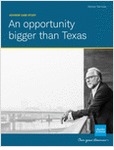The Federal Reserve held interest rates steady for a third meeting and gave its clearest signal yet that its aggressive hiking campaign is finished by forecasting a series of cuts next year.
Officials decided unanimously to leave the target range for the benchmark federal funds rate at 5.25% to 5.5%, the highest since 2001.
Policymakers penciled in no further interest-rate hikes in their projections for the first time since March 2021, based on the median estimate.
While Chair Jerome Powell didn’t foreclose on the possibility that officials could hike again if price pressures return, he indicated policymakers are now turning their focus to when to cut rates as inflation continues its descent toward their 2% goal.
Absent pushback on near-term rate cuts from the Fed chief, Treasuries surged and stocks jumped, while traders boosted bets on a March reduction to a near certainty.
Quarterly projections showed Fed officials expect to lower rates by 75 basis points next year, a sharper pace of cuts than indicated in September. While the median expectation for the federal funds rate at the end of 2024 was 4.6%, individuals’ expectations varied widely.
Eight officials saw fewer than three quarter-point cuts next year, while five anticipate more.

Powell emphasized the projections are not a pre-set plan, and said policymakers aren’t ready to take further interest-rate increases off the table if needed to quash resurgent price pressures.
Still, he acknowledged that officials at this week’s meeting discussed the question of when it will become appropriate to begin cutting rates.
“That begins to come into view and is clearly a topic of discussion out in the world and also a discussion for us at our meeting today,” he said at a press conference following the meeting.
A tweak to the Fed’s post-meeting statement on Wednesday also highlighted the shift in tone, with officials noting they will monitor a range of data and developments to see if “any” additional policy firming is appropriate.
That word was not present in the November statement from the US central bank’s policy-setting Federal Open Market Committee.
In another shift, the committee also acknowledged that inflation “has eased over the past year but remains elevated.” In addition, most participants now see the risks to price growth as broadly balanced.








 December 13, 2023 at 02:17 PM
December 13, 2023 at 02:17 PM












 Copyright © 2024 ALM Global, LLC. All Rights Reserved.
Copyright © 2024 ALM Global, LLC. All Rights Reserved.